BERMUDA TRIANGLE (PART 1 )
 •
by
•
by Apress
The area is one of the most heavily traveled shipping lanes in the world, with ships crossing through it daily for ports in the Americas, Europe, and the Caribbean Islands. Cruise ships are also plentiful, and pleasure craft regularly go back and forth between Florida and the islands. It is also a heavily flown route for commercial and private aircraft heading towards Florida, the Caribbean, and South America from points north.

Recently, American scientists who studied the sea near the famous Bermuda Triangle have found another "anomaly". They saw that the surface waters in this area are literally teeming with a wide variety of viruses. However, the viruses do not represent any danger for humans as they only interested in oceanic bacteria.
The very phrase "Bermuda Triangle" has appeared only recently - it was coined by a fan of Spiritualism and esoteric Vincent Gaddis in 1964. By this toponym he meant an area located between the island of Puerto Rico, the Florida coast and Bermuda. According to the famous mystic of the last century, this area of the Atlantic became notorious due to the fact that hundreds of ships and aircraft disappeared there. Some ships, however, were found later, but without their crews and passengers.
All this made Gaddis suggests that there was some anomaly in this area. However, he was not the first one to express this idea. In 1950 an American journalist Alexander Jones wrote an article about the mysterious disappearance of ships in this region (which he called simply and tastefully - Sea Devil). Yet, the Bermuda Triangle acquired real popularity in 1974, when Charles Berlitz, a popularizer of science, published a book under the same title where he collected descriptions of various mysterious disappearances in the area. The book immediately became a bestseller, and as a result the mysterious and dangerous Sea Devil became known to the entire world. After that different groups of scientists engaged in searching for reasons to explain these disappearances.
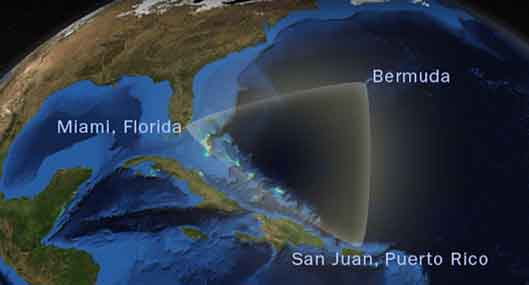
The boundaries of the Triangle vary with the author; some stating its shape is akin to a trapezoid covering the Straits of Florida, the Bahamas, and the entire Caribbean island area east to the Azores; others add to it the Gulf of Mexico. The more familiar, triangular boundary in most written works has as its points somewhere on the Atlantic coast of Florida; San Juan, Puerto Rico; and the mid-Atlantic island of Bermuda, with most of the accidents concentrated along the southern boundary around the Bahamas and the Florida Straits.
The area is one of the most heavily-sailed shipping lanes in the world, with ships crossing through it daily for ports in the Americas, Europe, and the Caribbean Islands. Cruise ships are also plentiful, and pleasure craft regularly go back and forth between Florida and the islands. It is also a heavily flown route for commercial and private aircraft heading towards Florida, the Caribbean, and South America from points north.
The Gulf Stream ocean current flows through the Triangle after leaving the Gulf of Mexico; its current of five to six knots may have played a part in a number of disappearances. Sudden storms can and do appear, and in the summer to late fall hurricanes strike the area. The combination of heavy maritime traffic and tempestuous weather makes it inevitable that vessels could founder in storms and be lost without a trace - especially before improved telecommunications, radar, and satellite technology arrived late in the 20th century.
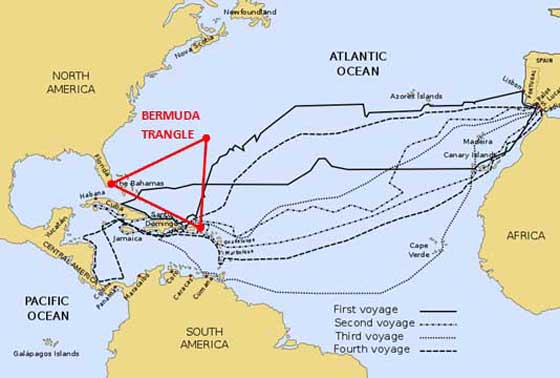
However, over time the skeptics slowly gained the upper hand over amateur mystics. No anomalies in this part of the ocean were found, and the U.S. Coast Guard has issued several reports according to which the disappearance of ships in the Bermuda Triangle did not occur more frequently than in other regions of the ocean, and they occurred mainly due to storms. Historians, digging in the archives, found that the area since the discovery of America was very often visited by various vessels, including pirate ones. Until the second half of the 20th century sailors made no mention of it as a mysterious place where ships were constantly perishing. Persnickety journalists analyzed Berlitz's book and found that most of the facts presented by the writer were not entirely true, and some were just made up.
By the 1990s, the interest in the Bermuda Triangle was largely exhausted. Recently, however, scientists regained interest in this area, because they did discover one anomaly there. However, it has nothing to do with the disappearance of ships and aircraft.
A team of U.S. scientists led by Professor Craig Carlson of the Bermuda Institute of Oceanology (St. George, Bermuda) have been conducting oceanographic research in the northwestern part of the Sargasso Sea for ten years, near the Bermuda Triangle and Bermuda islands. Recently a report on the work of the biologists has been published. Especially interesting in this report was the fact that, according to the observations of scientists, most numerous living organisms in the surface layers of the ocean in this region are viruses. Interestingly enough, the dynamics of these microscopic organisms is directly linked with the seasons. For example, in the summer viruses multiply actively in the water layers at depths ranging from 60 to 100 meters, and their number is up to ten million particles per drop of water. In the winter, sometimes they did not exist in the surface layers at all as they would go into the depths, following their masters.
New anomalous phenomenon discovered
The researchers analyzed the DNA of the viruses caught and found that 90 percent of them still were not known to science. However, these microorganisms, both known and unknown, did not present any danger to humans. They all belong to a group of bacteriophages, that is, the objects of their attacks are bacteria living in the ocean. Bacteriophages are known to be very old-fashioned and conservative as they do not change their habits, and do not attack other creatures.
To be able to reproduce, bacteriophages lie in wait for unsuspecting bacteria. They attach themselves to their cell walls and enter into the victim's DNA. Furthermore, they integrate into the genome of the bacteria (which is a single circular DNA molecule, lying freely in the cytoplasm and not protected by any walls). This makes them forget about their own responsibilities and focus on producing all the necessary molecules for the assembly of new viruses. This assembly also takes place inside the bacterial cell. When the number of newborn bacteriophages reaches several million, they come from the host cell, effectively breaking it into pieces, and then go in search of new victims.
The organic molecules of the dead bacteria fill the water surrounding them, and since bacteriophages kill hundreds of thousands of cells, it is not surprising that the sea surface in this place turns into a nutrient broth. Other bacteria hurry there for a feed and quickly become prey of cunning virus. This means that the bacteriophages form a microscopic ecosystem where they live.
Other marine creatures, unicellular and multicellular planktonic organisms, also enjoy the fruits of their work. Some are attracted by free nutrient broth, and others - by the bacteria feeding on it. It turns out viruses create a "cafeteria" in the surface layers of the sea. Even whales and dolphins come to eat there (these, in turn, are interested in swarms of krill feeding on microplankton and fish eating krill).
Scientists were amazed by what they saw because they did not know about this role of viruses in the formation of oceanic ecosystems. According to many oceanographers, oceanic viruses are very poorly understood because they are hard to catch. But now it is clear that they are countless in all seas and oceans.
"While we cannot see them with the naked eye, viruses are the dominant form of life in the ocean. They constitute 95 percent of the total biomass of the ocean. That is, the mass of virus is even larger than the mass of krill, fish and larger animals such as whales, combined. Given the pace of virus multiplication and their number, it becomes apparent how important their role in nutrient cycling on the planet is," said one of the authors of the study of biological "anomalies" of the Bermuda Triangle Dr. Rachel Persons. However, some experts believe that in this case there are no abnormalities specific to the Bermuda triangle as processes involving the viruses are occurring in many areas of the oceans. For example, biologists from the U.S. and Canada investigated the surface waters of the North Atlantic and reported that the most diverse viral community (129,000 genotypes) was found off the coast of British Columbia. The number of these microorganisms is also very high - approximately 50 million particles in a drop of water, which is five times greater than in the Bermuda Triangle. This "virus rage" is explained by the fact that this area has rising sea currents (upwelling), bringing nutrients from the depths of the ocean to the surface. In such areas sentient beings are more abundant and their diversity is higher than in the surrounding areas, and the virus is no exception to this rule.
It appears that the largest "virus carrier" on the planet is exactly in the oceans. It is fortunate that most of microscopic parasites living in it are not dangerous to humans.
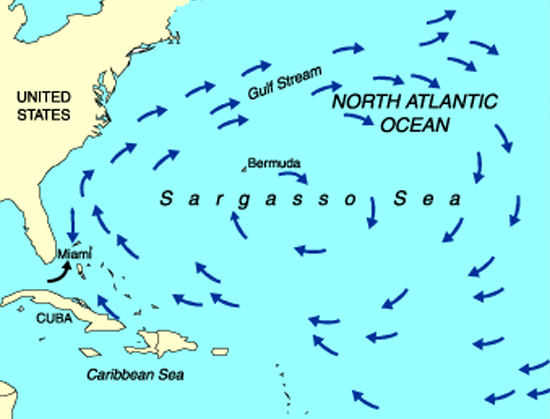
Natural Explanations
Methane Hydrates
An explanation for some of the disappearances focuses on the presence of vast fields of methane hydrates on the continental shelves. A paper was published by the United States Geological Survey about the appearance of hydrates in the Blake Ridge area, offshore southeastern United States, in 1981. Periodic methane eruptions are capable of producing ship-sized bubbles, or regions of water with so much dissolved gas, that the fluid density is no longer capable of providing adequate buoyancy for ships to float. If this were the case, such an area forming around a ship could cause it to sink almost directly and without warning. Experiments have proven that a methane bubble can indeed sink a ship by decreasing the density of the water.
Methane gas can also crash planes. The less dense air causes planes to lose lift. Also, the altimeter of planes (the instrument that measures the altitude) functions on the density of air. Because methane is less dense, the altimeter assumes the plane is climbing. Planes at night or in the clouds, where they can't see the ground, assume that they are climbing and dive, causing them to crash. Also, methane in the engine throws off the mix of fuel and air. Aircraft engines burn hydrocarbons (gasoline or jet fuel) with oxygen provided by the air. When the ambient oxygen levels drop, combustion can stop, and the engine stalls. All of these effects of methane gas have been shown experimentally.
Laboratory experiments carried out in Australia have proven that bubbles can, indeed, sink a scale model ship by decreasing the density of the water; any wreckage consequently rising to the surface would be rapidly dispersed by the Gulf Stream. It has been hypothesized that periodic methane eruptions (sometimes called "mud volcanoes") may produce regions of frothy water that are no longer capable of providing adequate buoyancy for ships. If this were the case, such an area forming around a ship could cause it to sink very rapidly and without warning.
A white paper was published in 1981 by the United States Geological Survey about the appearance of hydrates in the Blake Ridge area, off the southeastern United States coast. However, according to a USGS web page, no large releases of gas hydrates are believed to have occurred in the Bermuda Triangle for the past 15,000 years.
Hurricanes
Hurricanes are extremely powerful storms which are spawned in the Atlantic near the equator, and have historically been responsible for thousands of lives lost and billions of dollars in damage. The sinking of Francisco de Bobadilla's Spanish fleet in 1502 was the first recorded instance of a destructive hurricane. In 1988, Hurricane Gilbert, one of the most powerful hurricanes in history, set back Jamaica's economy by three years. These storms have in the past caused a number of incidents related to the Triangle.
Gulf Stream
The Gulf Stream is an ocean current that originates in the Gulf of Mexico, and then through the Straits of Florida, into the North Atlantic. In essence, it is a river within an ocean, and like a river, it can and does carry floating objects. A small plane making a water landing or a boat having engine trouble will be carried away from its reported position by the current, as happened to the cabin cruiser Witchcraft on December 22, 1967, when it reported engine trouble near the Miami buoy marker one mile (1.6 km) from shore, but was not there when a Coast Guard cutter arrived.
Freak Waves
Extremely large waves can appear seemingly at random, even in calm seas. One such rogue wave caused the Ocean Ranger, then the world's largest offshore platform, to capsize in 1982. There is, however, no particular reason to believe rogue waves are more common in the Bermuda region, and this explanation cannot account for the loss of airplanes.
Research has shown that freak waves up to 30 m (100 feet) tall, capable of sinking the largest ships within moments, can and do happen. Although these are very rare, in some areas ocean currents mean they happen more often than the norm. Such waves have now been hypothesized as a cause for many unexplained shipping losses over the years.
The book was a best seller, and many interested readers offered theories to explain the nature of the disappearances. The list includes natural storms, transportation by extraterrestrial technology, high-traffic volumes (and correspondingly high accident rates), a "temporal hole," the lost Atlantis empire from the bottom of the ocean, and other natural and supernatural causes.
Glowing Water
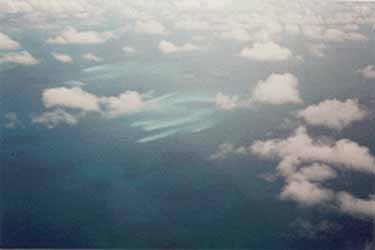
Aerial photos taken in 2005 show the phenomenon of glowing water. Whatever causes this phosphorescence to vent up from the Bahama Bank bottoms, if that is its cause, remains a mystery.
The Triangle's location in the Caribbean makes it subject to unpredictable weather patterns. This takes us to Earth changes and the excalation of intense hurricanes in 2005 with more to come in the years ahead.
These weather extremes prey on inexperienced navigators and smaller boats and planes. Water spouts, sudden electrical and thunder storms, and the like, can cause havoc in the area. The Gulf Stream can also be brutal in that region and perhaps has swept away evidence of natural disasters.
Electronic Fog
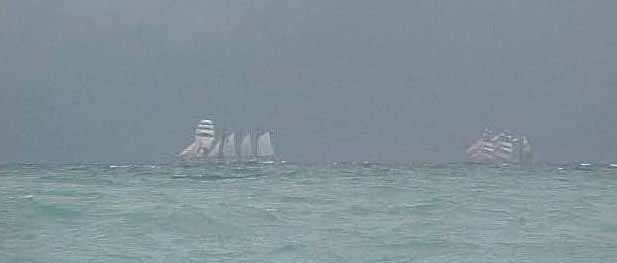
Many people have reported seeing portals opening in cloudy skies - strange swirling lights sometimes accompanied by sounds - temporal distortions - electromagnetic distortions called 'electronic fog' that can cause a time storm, and the disappearance of planes and ships. There is something about this fog that is important and gives one the sense of all things paranormal. Something unexplained is definitely happening in that region of the Atlantic. This goes back to ancient explorers such as Christopher Columbus and his crew who experienced the phenomenon.
 For the end,something for fun
For the end,something for fun





 By Apress on June 18, 2012 ®
By Apress on June 18, 2012 ®


Comments
super !!
voteee
😘
hvala and tnx \o o7
😘*
zanimivo čtivo
Vote!
vote
vote
tako lepo pise, steta sto je izgubio smisao za romantiku🙁
v+s
vote, sub!
157 v + sub
good luck
v: 158 s:186 good luck(:
http://www.erepublik.com/en/article/meglesz-m-g-ma--2062601/1/20
KisJ0zsi v69 +s 1001 done 😉 \o o7